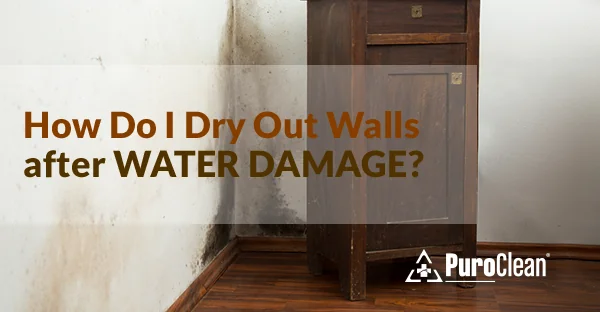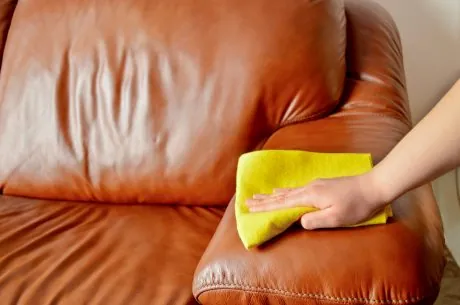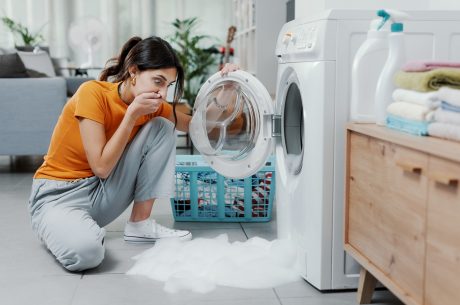
After an event that causes water damage in your home, not only would the floors be affected, but often the walls are as well. Thus, it’s essential to know how to dry wet walls—or call a restoration company immediately. Quick drying reduces the risk of structural damage and prevents mold from growing.
Understanding how water saturates drywall
Before you learn how to dry a wall after water damage, here’s a look into how water saturates drywall. Water that enters a room from ground level will cover the floor and floor covering. It will then begin to “wick” up the wall because of capillary action in porous materials. The extent of this movement depends on the wall’s construction, the amount of water, and the water’s height on the wall material.
Drywall is an absorbent material that contains gypsum and a cardboard-like paper on both sides. Drywall can wick water up to 30 inches! The water will be present on both sides of the wall. Often, however, it’s higher on the inside due to restricted evaporation on that side of the drywall. While water damage is sometimes visible, at other times, the wall does not show signs of this moisture.
How to dry a wall after water damage
To begin with, decide whether to handle the problem yourself or call a professional company. We recommend the latter if you don’t know how to dry wet walls or the damage is extensive. Sometimes, the water damage is obvious, but most times, it’s hidden, and those not trained in water damage restoration may miss it.
If you want to DIY, here’s how to dry wet walls out:
If a burst pipe led to the water intrusion, turn off the water source. Hire a plumber to fix the broken pipe before any drying can take place.
Accelerate drying by opening windows and doors. Use fans to move air around the damp walls. Dehumidifiers can help remove moisture from the air, which indirectly removes it from the walls, too.
To speed up evaporation, remove molding and baseboards to prevent moisture from entering behind them. Store the molding in a dry, safe place to avoid damaging it. Also, remove objects hanging on the wall, such as paintings and portraits.
Remove wallpaper if you have it. This takes patience, but it’s important as the wallpaper forms a “seal” that holds moisture in the wall. Wallpaper removal solutions, which dissolve the adhesive, are available at your hardware store. You will also need 3”-6” broad knives to scrape the wallpaper once released.
Note that fully drying out walls takes time, so don’t rush the refinishing until the walls are dry. A moisture meter can help you be sure. Once completely dry, you can reverse the process and refinish your room. Inspect the removed items for any moisture or mold growth before reinstalling.
Drying wet walls quickly and correctly is crucial. If you can’t dry your walls immediately, don’t let the problem get worse by waiting. Call a water damage remediation specialist and leverage their expertise, experience, and equipment.
How restoration professionals dry damp walls after water damage
First, technicians determine the extent of the water using a range of water damage restoration tools. One choice is a non-invasive moisture meter. This meter uses radio waves to test for water without putting holes in the wall.
Another professional instrument is an infrared imaging (IR) camera. Since the evaporation from wet walls makes them cooler than dry walls, the IR camera can find water in walls. It does so with no holes or other invasions of the wall material.
Once the professionals identify wet walls, they use specialized drying equipment to dry them.
If the walls aren’t insulated:
In this case, the restoration professional can dry wet walls out without holes or removing the baseboard. The technicians place high capacity air movers along the wall every 10 to 14 feet. These air movers remove moisture from wall’s surface, evaporating it quickly. As the moisture evaporates, more moisture goes to the surface where it evaporates.
The restoration expert will also install a low grain refrigerant dehumidifier in the damp wall. Depending on the moisture levels, one or more will be needed. This advanced drying equipment reduces the humidity levels to help with drying and prevent mold growth.
When proper, the restoration professional will install an inner-wall drying system by putting small holes above the sill plate and forcing air into the wall cavity. Studies have shown that this solution is the best and fastest way to dry walls with water damage.
Additionally, if there‘s a moisture barrier on the outside or inside the wall, the drying plan changes. Moisture barriers are coatings or materials that inhibit the movement of moisture from the wall material.
Most latex paints are permeable and don’t make up a barrier. But, glossy paints may create a barrier and enamel paint or vinyl wall coverings create a complete barrier. Technicians will need to perforate or remove them to allow moisture to escape and the walls to dry. If there’s plastic or foil on the inside of the wall, then technicians will need to remove the wall. That’s because drying will not occur properly and mold will develop in such situations.
If the walls are insulated:
If there is fiberglass insulation with paper backing, then an inner-wall drying system can be used, as described above. But, if the insulation is foil-backed fiberglass, blown-in cellulose, or a Styrofoam material, then it can’t be dried successfully.
In those cases, removing the damaged portion of the wall along with the insulation is necessary to allow rapid drying and to prevent mold growth.
Monitoring the drying system
Regardless of the procedures used by the restoration professional, homeowners should know that the equipment must operate, without stopping, throughout the drying process.
Finally, restoration professionals will monitor the drying system at least once a day. That ensures the equipment is operating correctly during the drying process. Monitoring includes moisture measurements to determine when the materials will successfully dry. Material dryness is measured against similar unaffected contents in that structure. When dryness levels are equal, the drying is finished, and the equipment removed.
To recap, this is how to dry out damp walls
- After addressing the water source, remove paintings and other objects from the wall.
- Follow up by removing moldings, baseboards, and wallpaper.
- Open windows and doors to help speed up the drying process.
- Use fans to move air around the damp walls. Also use dehumidifiers, which can help remove moisture from the air and walls.
- Professionals use tools like moisture meters, infrared imaging devices, dehumidifiers and heavy-duty fans. That ensures the walls are truly dry before further repair, painting or refinishing.
For drywall water damage drying and repair, call the pros!
A professional restoration company, such as PuroClean, understands and uses the principles and procedures of how to dry damp walls. For efficient drywall water damage repair, call your local PuroClean office. Our trained and certified technicians can dry walls and other items quickly and thoroughly, preventing further damage and mold growth.



